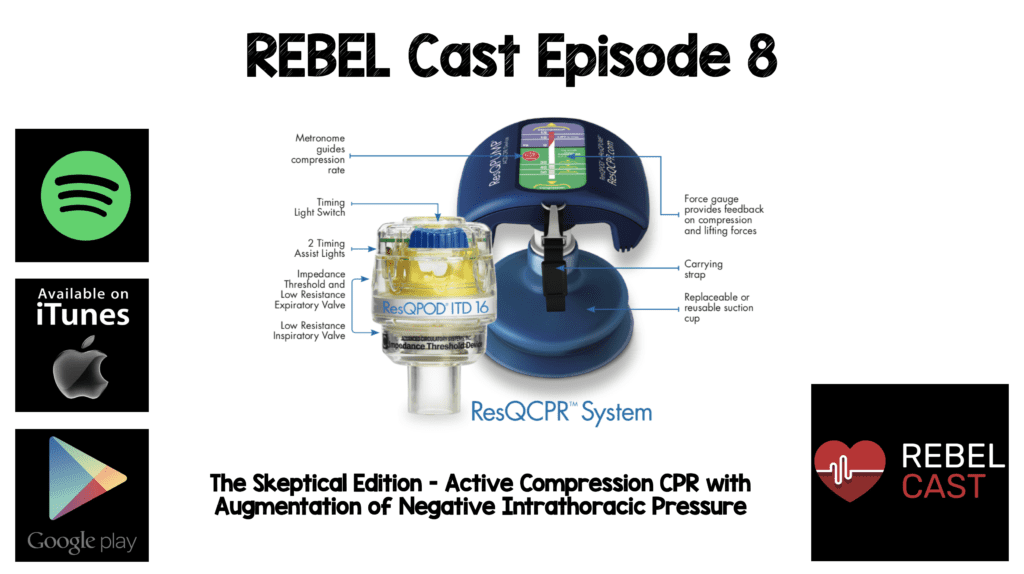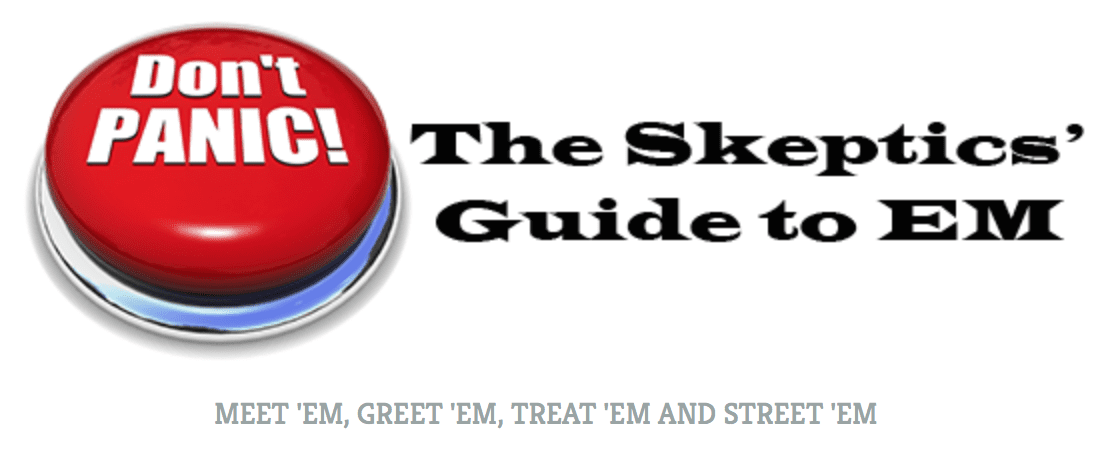
 Welcome back to a special edition, or should I say “skeptical edition” of REBELCast. We have started to do something new by inviting guests onto the show to discuss papers in the literature they find interesting. This month I had the pleasure of working with Ken Milne, an emergency room physician in Canada. Today, Ken and I are going to specifically discuss a new device that recently got FDA approval for CPR in Out of Hospital Cardiac Arrest (OHCA), and the question we are trying to answer is:
Welcome back to a special edition, or should I say “skeptical edition” of REBELCast. We have started to do something new by inviting guests onto the show to discuss papers in the literature they find interesting. This month I had the pleasure of working with Ken Milne, an emergency room physician in Canada. Today, Ken and I are going to specifically discuss a new device that recently got FDA approval for CPR in Out of Hospital Cardiac Arrest (OHCA), and the question we are trying to answer is:
Is active Compression Decompression CPR with Augmentation of Negative Intrathoracic Pressure for Treatment of Out-of-Hospital Cardiac Arrest superior to standard CPR?
REBEL Cast Episode 8: The Skeptical Edition – Active Compression CPR with Augmentation of Negative Intrathoracic Pressure
Click here for Direct Download of Podcast
Who is our guest this month on REBELCast?
 Our guest this month is Ken Milne, MD (Twitter: @thesgem) who has a fantastic podcast of his own called The Skeptics Guide to Emergency Medicine or The SGEM for short. The SGEM is a knowledge translation (KT) project started in 2012. The goal of the SGEM is to cut the KT window from over 10 years down to 1 year. The SGEM does this by using social media to provide the audience with high quality, clinically relevant, critically appraised, evidence based information, so you can provide EM patients with the best possible care. The SGEM consists of a weekly blog and 20min podcast. Each week Ken invites a guest skeptic to perform a critical appraisal on a recent article while trying to find the right balance between education and entertainment.
Our guest this month is Ken Milne, MD (Twitter: @thesgem) who has a fantastic podcast of his own called The Skeptics Guide to Emergency Medicine or The SGEM for short. The SGEM is a knowledge translation (KT) project started in 2012. The goal of the SGEM is to cut the KT window from over 10 years down to 1 year. The SGEM does this by using social media to provide the audience with high quality, clinically relevant, critically appraised, evidence based information, so you can provide EM patients with the best possible care. The SGEM consists of a weekly blog and 20min podcast. Each week Ken invites a guest skeptic to perform a critical appraisal on a recent article while trying to find the right balance between education and entertainment.

Finally, the SGEM uses a validated and reliable tool from the McMaster University the home of evidence based medicine. The tool comes from the Best Evidence in Emergency Medicine (BEEM) group. It is used to probe the literature.

Topic: Active Compression Decompression CPR with Augmentation of Negative Intrathoracic Pressure
Question: Is active Compression Decompression CPR with Augmentation of Negative Intrathoracic Pressure forTreatment of Out-of-Hospital Cardiac Arrest superior to standard CPR?
Article: Aufderheide et al. Comparative Effectiveness of Standard CPR versus Active Compression Decompression CPR with Augmentation of Negative Intrathoracic Pressure for Treatment of Out-of-Hospital Cardiac Arrest: Results from a Randomized Prospective Study. Lancet. 2011 January 22; 377(9762): 301–311. PMID: 21251705
Background: Sudden cardiac arrest is very common and in the United States, there are about ½ a million cardiac arrests every year. About half of these cardiac arrests are out-of-hospital cardiac arrest and the survival rate is pretty poor with recent survival estimates of 7 – 9.5%.
Details of the Study:
-
Population: Adults with OHCA of presumed cardiac origin
- Excluded:non-cardiac arrests, trauma, stroke, over dose, electrocution
- Intervention: Active Compression Decompression (ACD) CPR with Augmentation of Negative Intrathoracic Pressure
- Comparison: Standard CPR
- Outcome: Primary was survival to hospital discharge with good neurologic function (modified Rankin Scale of three or less)
Results:
- The survival to hospital discharge with a modified Rankin Score of three or less:
- 75/840 (8.9%) vs. 47/813 (5.8%), p=0.019, OR 1.58 [CI= 1.07, 2.36].
- They report this as 53% relative increase in survival (absolute was 3.1% NNT=33)
- If you had used mRS of two or less the results are 6.2% vs. 4.6% (absolute difference 1.6% NNT=63) favoring the intervention.
- The HARM: increase pulmonary edema in intervention group
Limitations:
- This was an industry-sponsored trial: This does not negate the results but should always make people a bit more skeptical. The sponsor helped in designing the study, data interpretation, writing and decision to submit the paper for publication.
- The study was terminated early due to lack of funding: The original study called for total of 1,400 patients. A pre-planned interim analysis recommended upping the sample size to 2,700 to have 80% power to detect a difference. At the time of termination they had only enrolled 1,653 patients. This means there were 1,000 patients (37%) short of required target size. This limits making any strong conclusions on the primary outcome and severely limits any comments that could be made about secondary outcomes and subgroup analyses.
- The two groups were not treated equally post randomization. The intervention group received much greater cardiac care:
- Cardiac catheterization (33% vs. 42%)
- Coronary stenting (13% vs. 16%)
- Coronary bypass surgery (3% vs. 6%)
- Cardio-defibrillators (14% vs. 17%)
- This trial was registered at ClinicalTrial.gov. While some of the secondary outcomes were reported others were not. This included the survival at 30 days and the neurological recovery at 30 days on mRS. There were three other neurologic scores collected but not reported. They only reported the Cognitive Abilities Screening Instrument (CASI) at 90 and 365d (not at 30d). They did not report the following outcomes at discharge, 30d, 90d or 1 year:
- Cerebral Performance category (CPC)
- Overall Performance Category (OPC)
- Health Utilities Index Mark 3 (HUI3)
- They present a Beck’s Depression Index, which was not in their original 2005 study design or updated secondary outcomes in 2012.
What is the clinical bottom line for the above clinical question?
- It is not clear if this device works in improving survival with good neurologic outcomes for patients with OHCA, but this study does not prove that it does.
- The other take home point would be – Remember to be skeptical of anything you learn, even if you heard it on the Skeptics’Guide to Emergency Medicine or in this case REBELCast!!!
Be sure to checkout REBEL EM on some of our other social media platforms:
The post REBEL Cast Episode 8: The Skeptical Edition – Active Compression CPR with Augmentation of Negative Intrathoracic Pressure appeared first on REBEL EM - Emergency Medicine Blog.
